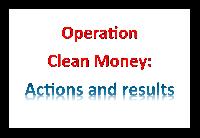
Operation Black Money: Actions and results
The Operation Clean Money (OCM) initiative was launched by the Income Tax Department (CBDT) for e-verification of large cash deposits made during the period from 9th November to 30th December 2016. The programme was launched on 31st January 2017 and has entered into the second phase in May 2017. As part of the initiative, Email and SMS were sent to 18 lakh taxpayers for submitting online response on the e-filing portal.
The operation is primarily aimed to verify cash transaction status (exchange/savings of banned notes) of tax payers during the demonetisation period and to take tax enforcement action if transactions doesn’t match the tax status. According to the ITD, one of the pillars OCM is fair, transparent and non-intrusive tax administration. As mentioned, the OCM has two phases so far and updates in the form of OCM status are published by the ITD accounting the action taken on the accounts revealed.
First Phase
The first phase of Operation Clean Money focused on three key areas:
- preliminary assessment,
- e-verification process, and
- targeted enforcement actions.
1. Preliminary Assessment
As part of the preliminary assessment, the accounts depositors during demonetisation are assessed in line with their tax profile. The status report shows that accounts of 17. 92 lakh persons were identified for verification process after online processing. They were requested for on-line responses on such transactions. (Under the second phase of OCM, additional 5.68 lakh people were identified). During this preliminary assessment, the distribution of large cash deposits across various taxpayer segments (e.g. Business, Non-business etc.) were analysed.
2. E-verification Process
Once identified, the account/PAN holders are informed at the e filing window of the Income Tax Department. The taxpayer was able to submit online explanation without any need to visit Income Tax office. Supporting facilities like FAQs, detailed user guide, were published by the Department to assist the taxpayer in submitting online response. Email and SMS were sent to taxpayers for submitting online response on the e-filing portal. ITD also released advertisements to educate taxpayers about registration and submission of online response.
The status report says an encouraging 13.33 lakh responses (out of the total 17.92 accounts) involving cash deposits of around Rs.2.89 lakh crore have been made by the people without visiting Income tax office. Taxpayers provided details of additional 41,600 bank accounts in which cash was deposited.
After the submission of explanation by persons, the Department decided to close verification cases where explanation of source of cash was found to be justified. In cases where the cash deposit has been declared under Pradhan Mantri Garib Kalyan Yojna (PMGKY), the verifications would also be closed.
3. Enforcement actions
The ITD after processing the data of persons, has identified high risk cases for initiating enforcement actions. Salient features of enforcement actions undertaken by ITD during Phase I of Operation Clean Money were as under:
- Search actions were conducted on nearly 900 groups and assets valued at Rs. 900 crore including cash were seized.
- Survey actions were conducted in 8,239 cases in which undisclosed income of Rs. 6,746 crores was detected.
- More than 400 cases were referred to ED/CBI and arrests were made.
Second phase
The main thrust of second phase of OCM is identification of high risk persons for detailed investigations by the ITD. Two specialized data analytics agencies and a business process management agency were created on-board to augment departmental capability in analyzing large volume of cash deposit data and to track the compliance status of taxpayers and reporting entities.
During the second phase, around 3.71 lakh accounts relating to 1.58 lakh old cases were identified, which were not disclosed in previous responses. Similarly, 5.68 lakh new cases (in addition to earlier 17.92 lakh cases) are identified for e-verification process. Phase II of Operation Clean Money includes following set of activities:
- Comprehensive risk assessment
- Differentiated targeted treatment
- Enable citizen engagement
- Identification of new cases for online verification
- Identification of high risk cases using advanced analytical techniques
- Ensuring complete and accurate reporting of information
A comprehensive risk assessment (rule based) framework has been developed to identify cases with different levels of risk (High, Medium, Low, and Very Low).
|
Risk Category |
Number of Persons |
|
High Risk |
1.00 lakh |
|
Medium Risk |
7.54 lakh |
|
Low Risk |
5.95 lakh |
|
Very Low Risk |
3.41 lakh |
Approach of OCM: Differentiated Targeted Treatment
The OCM follows a differentiated and targeted treatment while chasing black money. As part of this differentiate targeted treatment, the high-risk cases will be handled by selecting appropriate enforcement action (verification, search, survey, scrutiny). The key components of the targeted campaign are:
- Communication through digital channels (Email, SMS etc.) to persons
- Providing detailed explanation to create environment of transparency
- Explain investigation findings for specific segments (e.g. jewellers, petrol pump, traders, property purchasers etc.)
- Centralised monitoring for cases of inadequate response for enforcement action.
The low risk cases will be monitored for tax compliance and corrective action will be taken at appropriate time.
*********










